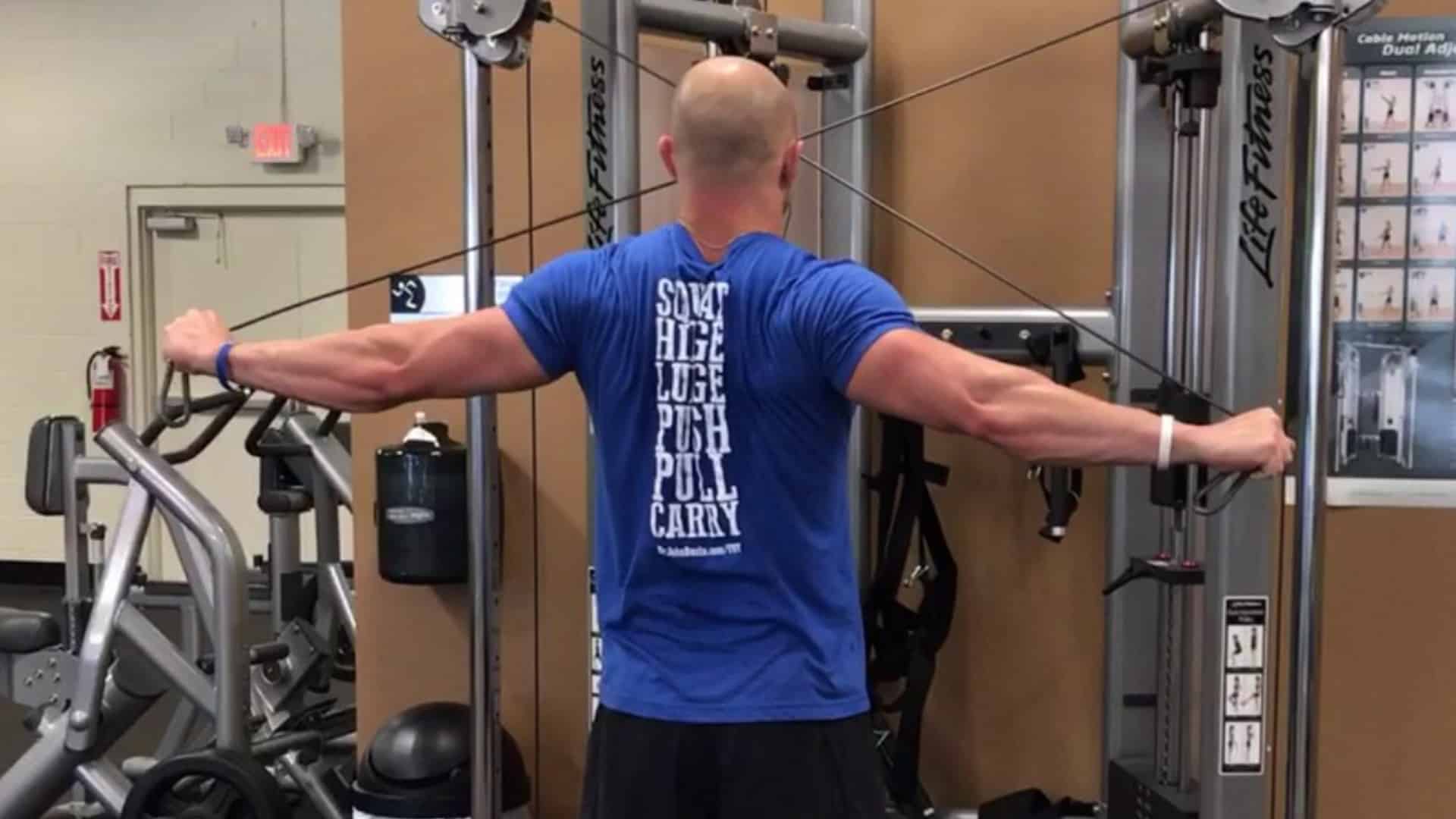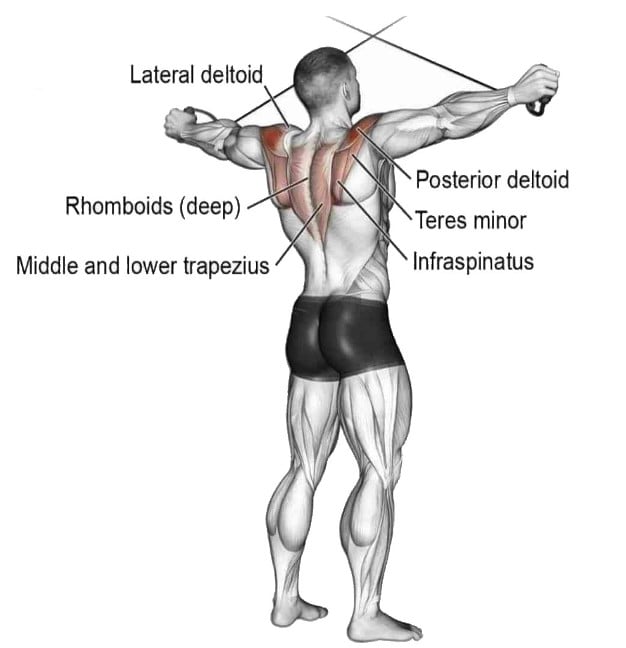If you’re looking for an effective exercise to enhance your upper back and shoulder development, look no further than reverse cable crossovers.
The reverse cable crossover helps you to strengthen and tone the rear deltoid muscles. It is a good exercise for building muscle and strength in the deltoids and upper back muscles.
In this article, you will learn about the:
- What is Reverse Cable Crossover
- Muscle worked during reverse crossover
- Its benefits
- Its alternatives.

- What Is Reverse Cable Crossover
- Muscles Worked During Reverse Cable Crossover
- Benefits of Reverse Cable Crossover
- How To Do Standing Cable Reverse Crossover
- Reverse Cable Crossover form and Tips
- Sets and Reps
- Best Alternate of Reverse Cable Crossover
- 1. Bent Over Dumbbell Lateral Raise
- 2. Cable High Row
- FAQs
- Are reverse cable crossovers good for back?
- Conclusion
- Best Shoulder Exercises To Build Mass and Strength
What Is Reverse Cable Crossover
The reverse cable crossover is an effective exercise for targeting the posterior deltoids and upper back muscles, helping to improve shoulder stability, enhance muscle definition, and strengthen the upper body.
Unlike the traditional cable crossover where the arms cross in front of the body, in the reverse cable crossover, the arms move behind the body.
The reverse cable crossover is sometimes referred to by other names, such as
- Standing cable reverse fly
- Reverse cable fly
- Rear deltoid cable fly
- Cable reverse fly
Muscles Worked During Reverse Cable Crossover
During a reverse cable crossover, the primary muscles worked are the Rear deltoids (Back of the shoulders) and the rhomboids.
The secondary muscles that are engaged during the exercise include:
- Lateral deltoid,
- Trapezius
- Rotator cuff muscles
Other muscles that contribute to stability and support during the movement include:

Benefits of Reverse Cable Crossover
Here are some of the benefits of doing a cable reverse crossover:
- Targets the rear deltoids for better shoulder development and definition.
- Activates the upper back muscles, including the rhomboids and trapezius, for improved strength and posture.
- Enhances shoulder stability and mobility by engaging the rotator cuff muscles.
- Promotes aesthetically and functionally balanced shoulders
- Build symmetry with the shoulder, preventing a “forward sloping” look.
- Aids in creating a well-rounded and sculpted upper body appearance.
- Improve shoulder function.
- Prevent shoulder injuries.
How To Do Standing Cable Reverse Crossover
Your arms should move directly back (and downward slightly) almost parallel to the floor to target the posterior deltoid.
If the hands are raised through a higher arc to a point above shoulder level, the trapezius and lateral deltoid make a bigger contribution to the movement.
Crossing your hands over one another (uncrossing the cables) at the start position increases the range of motion.

- Stand in the center of a cable crossover apparatus.
- Plant your feet on the floor shoulder-width apart and bend your knees slightly.
- Start with hands crossed in front of you at shoulder height, with the left high cable in your right hand and the right in your left hand.
- While maintaining a slight bend in your elbows and by using your rear delts, pull your elbows out and back until your arms are inline with your shoulders.
- Gently draw the cable ends forwards and inwards to return to the starting position.
- Repeat the desired number of reps.
Reverse Cable Crossover form and Tips
- The posterior deltoid is best targeted with your torso upright, not leaning too far forward or back.
- Keep a controlled motion and avoid jerky movements.
- Avoid bending your elbows, shrugging your shoulders, and changing the plane of your arm movement.
- Maintain a fixed slightly bent elbow position throughout exercise.
- Pull slowly so that you are in control of the weight at all times.
- Remember to exhale while you exert.
Sets and Reps
- Do 3-4 sets of this exercise.
- Reverse cable fly is an exercise with light weight, so you have to do 12-15 reps for each set.
- Take 60-90 seconds break in between sets.
Best Alternate of Reverse Cable Crossover
You can replace (combine) reverse crossover exercise with lots of other exercises. There are plenty of other posterior deltoid exercises you can perform using cables, machines, and dumbbells.
1. Bent Over Dumbbell Lateral Raise
Bent over raises, exercise, hit specifically the rear delt head by isolating it better than any other shoulder exercise. This exercise can be performed in both a standing and a seated position. Prefer the seated version as it calls for strict movement.
2. Cable High Row
Half kneeling high cable row rope is a tremendous exercise that effectively works many muscles, including the shoulder, back, wing and trapezius muscles.
Using this exercise gives people with shoulder issues an exercise to get the benefits of rows. In addition, face pull is one of the most effective corrective exercises that help compensate for poor posture and shoulder dysfunction
FAQs
Are reverse cable crossovers good for back?
Yes, reverse cable crossovers are beneficial for the back. They primarily target the posterior deltoids (rear delt) and engage the upper back muscles, including the rhomboids and trapezius.
Reverse cable crossovers improve back strength, posture, and muscle development.
Conclusion
This exercise develops the rear deltoids—the rear muscles of your shoulders—and helps to give your shoulders a three-dimensional appearance.
Best Shoulder Exercises To Build Mass and Strength

Manish brings over 10 years of hands-on experience in weight lifting and fat loss to fitness coaching. He specializes in gym-based training and has a lot of knowledge about exercise, lifting technique, biomechanics, and more.
Through “Fit Life Regime,” he generously shares the insights he’s gained over a decade in the field. His goal is to equip others with the knowledge to start their own fitness journey.
